Rian Johnson’s journey into the not-too-distant future with Looper brought with it an accompanying trip into the world of visual effects, something the director was initially hesitant to do. But guided by visual effects supervisor Karen Goulekas and teams of artists across the globe, Looper ended up with 388 shots. fxguide looks at just some of the key sequences from the film.
*****Warning: this article contains major plot spoilers.*****
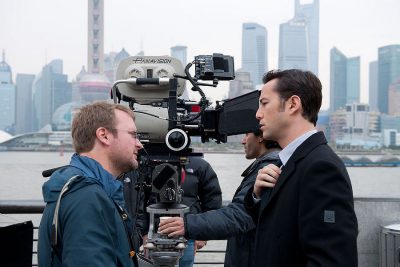
“Rian came from a point of view of initially that all visual effects looked like cartoons,” says Goulekas. “I said, ‘No that’s just the bad visual effects – when they’re done well you don’t even realize they’re effects’. I’m happy to say at the end of this project he no longer thought that all visual effects looked like cartoons.”
Partly, that came from the director’s wish that Looper, although set mostly in 2044, did not evoke a typical futuristic feel. There are glimpses, of course, in buildings, vehicles and even farm equipment, and in the depiction of telekinesis powers (a mutation in humans), but mostly the film’s grim reality of 30 years from now is, just that, grim. To create that gritty feeling, the production filmed in Louisiana, standing in for a future Kansas City. In this future city, assassins – ‘Loopers’ – kill and dispose of agents sent back in time from 2072. In the film’s present (2044), Joe Simmons (Joseph Gordon-Levitt) is faced with killing a future version of himself (played by Bruce Willis). Scenes were also filmed in Shanghai, which is juxtaposed as a successful and prosperous metropolis.
Only limited concepts and visual effects development were defined early on – although the film was extensively storyboarded – with the director choosing to shoot as candidly as possible and without calling attention to the futuristic setting. That also applied to the film’s central conceit – time travel – in which travelers are literally revealed as a ‘one frame pop-on’. “At first I was, like, ‘Wow, we’re not going to do anything?’,” recalls Goulekas, “and then I ended up liking it. The only shot we ended up turning into something was when Old Joe disappears, and Rian decided we did need a little bit of an effect when he disappears and is sent back to the future.”
– Watch Atomic Fiction’s breakdown reel.
Ultimately, Goulekas relied on three main vendors for the principal shots – Atomic Fiction, which completed the cityscapes, Hydraulx which handled the Old Seth limb removals, blood effects and the slat bike confrontation, and ScanlineVFX Munich, responsible for creating the finale. In addition, significant rig and wire removal, compositing, graphics, signage, sky replacement, environment and speed change work was completed by Incessant Rain Studios, Base FX and Pixel Magic. In what Goulekas refers to as ‘combos’, many individual shots were also shared by two or even three vendors.
The cities of Looper
To bring both the derelict Kansas City surrounds and the clean future-Shanghai to life, Goulekas turned to Atomic Fiction and visual effects supervisor Ryan Tudhope. The studio was initially engaged to create concept art for the cityscapes, but Goulekas and the director were so impressed by Atomic Fiction’s designs and ideas that the studio worked on these shots to completion.
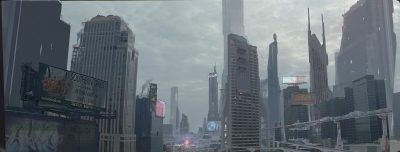
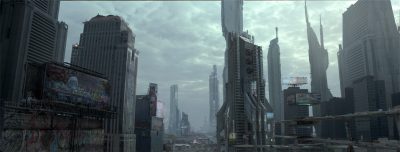
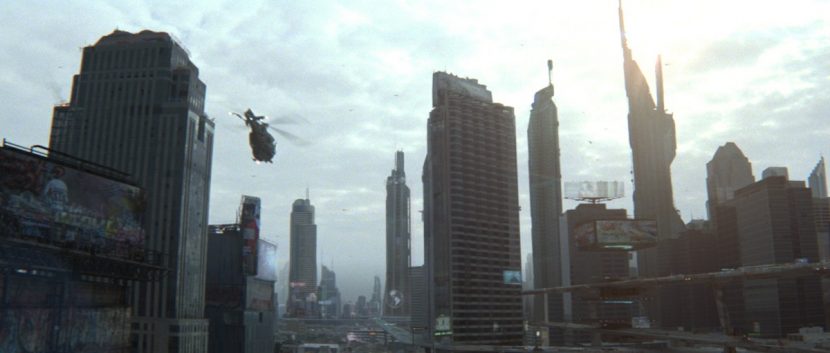
“They just got it from the get-go,” says Goulekas. “Sometimes you work with people and you can’t say exactly what it should look like, you go round and round in circles. But these guys got it and put stuff in front of us, and we would say yes, no, maybe, and move on. It was great.”
Ultimately, Atomic Fiction produced around 30 pieces of concept art, working directly on the filmed plates. “It was a post-concept phase, so we were working with footage that had already been shot. That allowed us to be more targeted and efficient about it,” notes Tudhope. “To his credit, Rian Johnson didn’t want it to feel too fantastic or out there – he wanted it to feel very grounded and didn’t want it to detract from the story, so that defined our approach.”
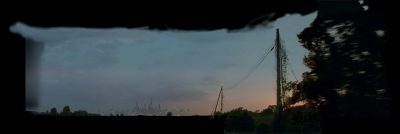
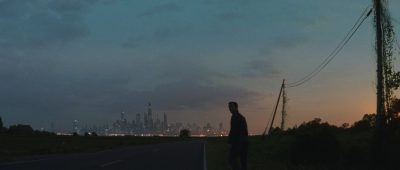
The promising concept results segued into the actual shots for Atomic Fiction, as they tackled the gritty Kansas City. These were made up of wide views of the city, key extensions to street-level shots and also the addition of aerial vehicles and other important features conceptualized by Atomic. “Concept artist Chris Stoski and I wanted to make things look tacked onto the buildings,” says Tudhope, “where they maybe have gone through a generation or two of enhancements – as if the architecture becomes a mix of styles. We found ways to incorporate graffiti and have areas taken over by squatters. So there’s a shot where one of the futuristic helicopters flies past one of the main characters and you see through the windows – if you look carefully there’s a tent on the roof across the way and various futuristic air-conditioning units.”
For the buildings, Atomic Fiction artists modeled in Maya, applied textures and shaders, and then rendered in V-Ray via ZYNC, a cloud rendering solution. Matte painting work was achieved in both Photoshop and 3DS Max, and final compositing done in Nuke. Tudhope says clever methods were relied on to re-use portions of buildings for various shots, a way of also creating a common thread amongst the scenes.
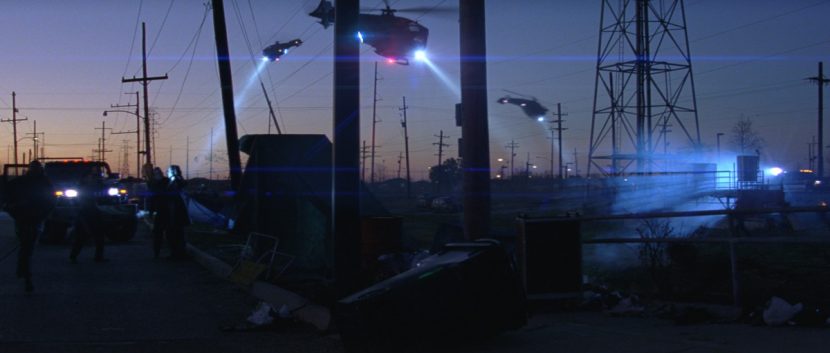
The creation of the futuristic aerial vehicles followed a similar toolkit pipeline, and were particularly inspired by scenes from seminal future-movie Blade Runner. “Often times vehicles at night just become big flares and silhouettes,” explains Tudhope. “So while our vehicles were extremely detailed and had every little panel figured out by our modeler, one of the things I’m never afraid to do is throw some of the stuff away and let it become a silhouette. Some of those subtle details come out here or there when the light glints across it, but I really like when things are subtle and you show the reality of what you’d get if you actually filmed it.”
Close attention was paid to the searchlights on the aerial vehicles as they look for Joe, matching flares achieved in-camera based on the anamorphic lenses used by production. “Karen has a really great eye for this,” says Tudhope. “She found great reference and we talked through what it was about these searchlights – the way the color saturation falls off on the edges towards blue, what the fall-off looks like and the subtle details of the changes in the atmosphere that make the searchlights flicker.”
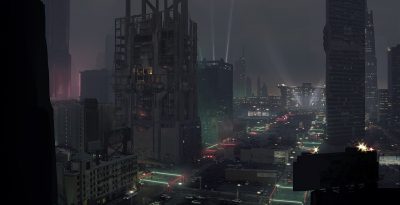
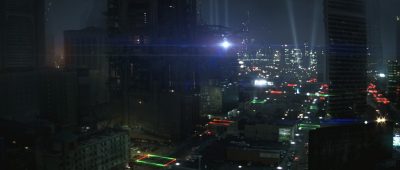
One stunning shot requiring city extensions was of Joe falling from his balcony onto a car. The shot was mostly achieved practically, with the exception of an Atomic Fiction-created CG Gat Man also falling. “Atomic added in the buildings, and then Base and Incessant did rig removals for that shot,” says Goulekas. “Atomic also added the Gat Man’s CG shoe rolling away which Rian was really impressed with!”
In addition to Kansas City scenes, Atomic Fiction contributed key views of Shanghai, including one of a cargo ship traveling down a waterway. The shot actually began as a stock footage plate of San Francisco, with artists ‘futurizing’ the foreground bridge, replacing buildings and augmenting the topology. “There was also a helicopter move on it that really added a lot of depth and dimension to the shot,” says Tudhope. “We reconstructed the San Francisco Bay to add additional islands with the structures, and an additional dock. We also enhanced a cargo ship out on the water. It was a good old-fashioned establishing shot.”
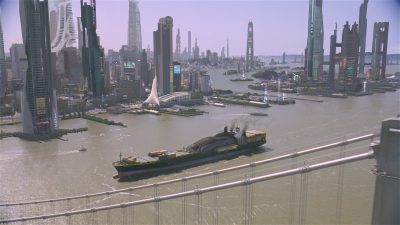
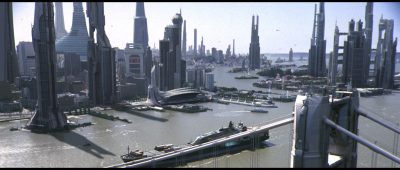
Old Seth
Loopers are acutely aware of another grim reality in the profession – that one day they may be forced to assassinate their future selves. When a Looper fails to carry out this task, the mafia-inflicted penalty is death to both people, although not before some finely focused torture. This is illustrated in the film when Seth (Paul Dano) lets his older self – sent from the future – free. As Old Seth (Frank Brennan) attempts an escape he literally begins to lose body parts, the result of the mafia capturing Young Seth and, slowly, surgically cutting off his limbs that immediately transfer to his older being.
Hydraulx pulled off the Old Seth work under visual effects supervisor Chris Wells. On set, Goulekas filmed scenes of Old Seth – with limbs intact – using multiple witness cameras and marker dots to aid in body tracking. “We had done a life cast of the actor,” she explains, “and the makeup effects team drilled holes in it so that every day I could put it on his face and the tracking marks would be in the exact same place – green if day time or white if night time. Then we used Canon 7Ds, set at 45 degree angles to the main camera to give Hydraulx three views so they could figure out in 3D space where he really was.”
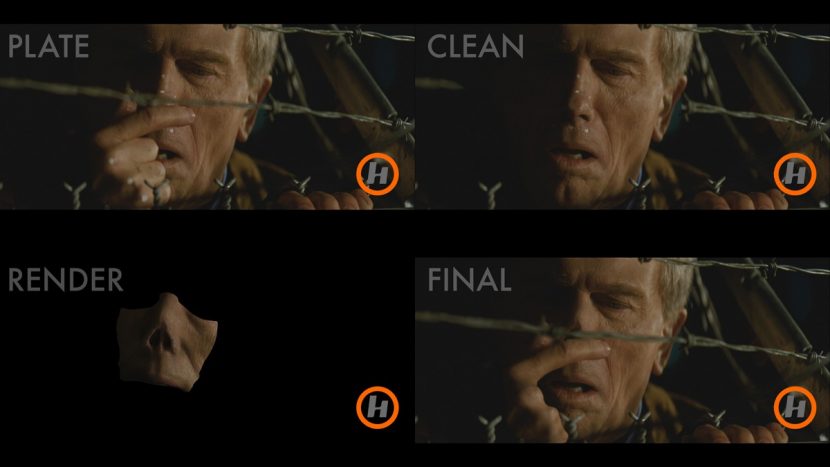
A cyberscan of Frank Brennan’s hands and nose were also provided to Hydraulx, which re-created portions of the actor’s face and body parts in CG. “We had 3D augmentations of his nose socket and stumps where his fingers used to be, for example,” explains Wells. “We roto’d it in 3D, tracked it on and merged it together in comp which was crucial because it let us control all the lighting.”
One of the most challenging parts of the sequence came as Old Seth – who suddenly sees an address and cry for help scratched into his arm by the younger Seth – manically drives to try and save himself. But mid-journey Old Seth’s foot disappears and he is unable to control the vehicle, slamming into a telegraph pole. He makes his way to the address, all the while losing his nose cavity, fingers and more limbs, pounds on the door with only his stumps, only to see Young Seth die on an operating table, and then succumbs himself to a gun blast from hit-man Kid Blue (Noah Segan).
Production filmed the car crash as two separate plates, firstly with a stunt driver smashing into the pole, and then with Brennan exiting. Hydraulx had to seam together the shots – done during a camera pan – and then remove and replace Old Seth’s limbs. “The actor walked out of the car, performed his action with his limbs in tact and we removed them,” says Wells. “We combined the two plates, and added a trash bin that he hit, put some of the futuristic lights in the background and replaced the walls. We had to create clean backgrounds and then do simulations of 3D pants, shoes, a digital head, digital hand, and comp it together.”
The 3D body parts were modeled and rigged in Maya, with nCloth used for the clothing. The CG work was rendered in Mental Ray and composited in Inferno and Flare, with roto done in Combustion. Matte paintings in Photoshop filled out the backgrounds.
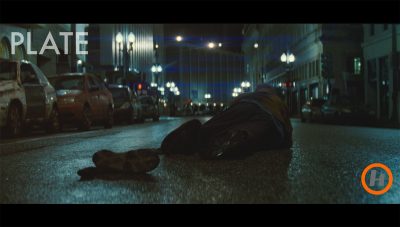
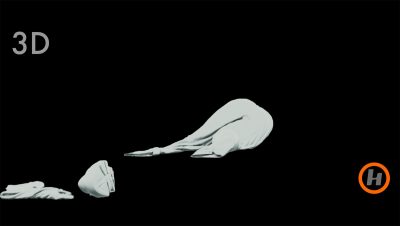
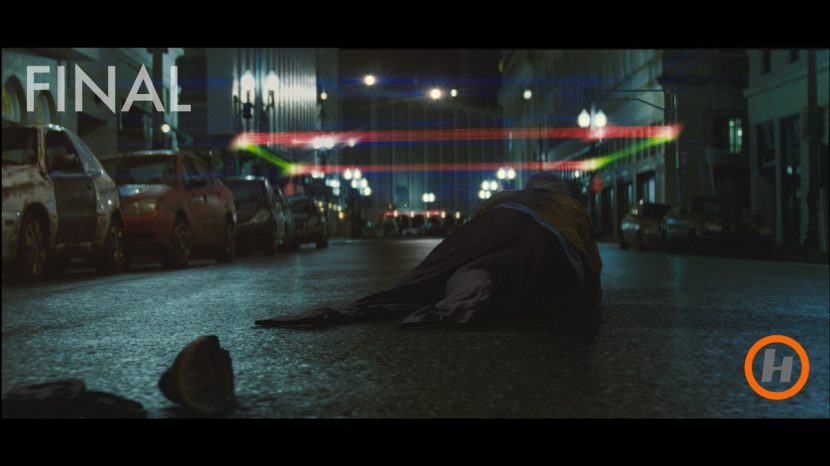
Wells says the hardest part of the Old Seth shots was tracking. “There are a lot of subtle muscle movements on every part of your body,” he notes. “But once you nail the tracking down, things fall into place a little bit. The second thing is having a high enough skin resolution – you can do a lot of 2D tricks with re-projections and patches, but as we were doing a lot 3D renders, we had to get a 3D shading and lighting look, and high quality texture maps to match. Plus you need to get the shadows right, and we were very close on the actor’s face.”
“The one thing that will go unnoticed,” suggests Wells, “is that we built the ground and sidewalk and rendered out an entirely 3D ground plane. The only thing left in the original plate were cars in the background and everything else is 3D rendered. We even had to rotate different pieces of the car around to look like it did crash and break, and we added dynamics to the top and bottom to integrate the first and second plate. It’s funny – our reaction when we saw the shots was, ‘Oh man, that’s going to be hard, that’s awesome!'”
The truth is revealed
Eventually, the inevitable happens, and Young Joe is forced to assassinate his older self. But Old Joe manages to escape, intent on preventing a future where a new mafia boss – The Rainmaker – wreaks havoc. Old Joe seeks out clues to the boss’ existence in 2044 (the present), while Young Joe tries to make amends with the mafia for not carrying out the killing. Eventually this leads Young Joe to a farm outside of Kansas City, where Sara (Emily Blunt) is taking care of a mysterious little boy, Cid (Pierce Gagnon).
See how production filmed the slat bike.In the process, Young Joe confronts Kid Blue, who is riding a hover or ‘slat’ bike. Seen also in some city shots, the bike was filmed on a greenscreen rod being pulled by a truck, requiring rig removals and replacements. The Kid Blue sequence was made more challenging by the addition of a smokescreen Joe creates by firing at the road to throw his assailant off the bike. Hydraulx handled bike and smoke, while the scenes were once again a combo effort between different vendors for the distant city, sugar cane duplication and sky replacements.
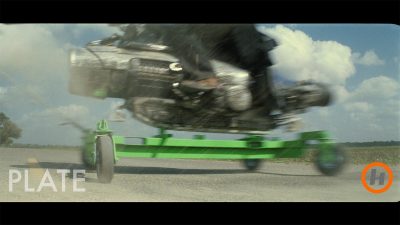
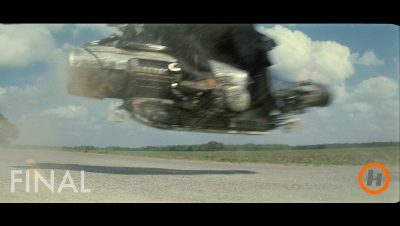
“We modeled the bike so we could put a jet in the back of it as a dynamics pass,” says Wells. “We did a lot of heat distortion and dust coming out of it, which helped with integration. They had a stunt bike but we also used a digital one to control the shots a lot more with the smoke. We could also throw the CG bike through there and have it interact with a volume of FumeFX smoke and get that to work.”
Meanwhile, the mafia continues to hunt down both Joe’s, sending Jesse (Garret Dillahunt) on their trail. When Jesse arrives at the farm house, Cid’s true powers – via telekinesis – are revealed, as he makes the hit-man and a room full of furniture levitate. Wire removals for chairs and tables were handled by Base FX and Incessant Rain. Jesse is then killed mid-air as a spurt of blood emanates in slow-motion from his body. “Conceptually that was a tough one,” says Karen Goulekas. “Rian wanted it be organic and like a flower unfurling. That’s a really vague thing but Hydraulx did some iterations and Rian saw what he was looking for.”
Hydraulx had also delivered several other blood hits for the film, creating fluid sims in RealFlow and FumeFX based on blood bag reference. “The Jesse shot was particularly interesting because it was slow-moving,” explains Chris Wells. “Our first take at this was a smokey/ethereal look and that didn’t quite feel right. We shied away from particle effects and went into fluids – it had a slow, silken, flower look, seeping out of him. We had the stunt guy up there on wires, removed those, tracked his 3D body, and then did a specific sim for that shot.”
Cid’s power – the finale
Old Joe confronts Sara and Cid amongst a field of sugar cane and threatens to shoot them. But Cid unleashes his full telekinetic abilities, causing Old Joe and Sara to levitate and creating a huge shockwave of dust and debris. Realizing he has the power to save both Cid and Sara, and prevent Cid from becoming The Rainmaker, Young Joe takes his own life (and that of his older self). ScanlineVFX Munich handled the principal shots for the finale.
Watch a side-by-side breakdown of Scanline’s shots for the finale.“I’ve found in particle sims,” comments Goulekas, “that if you approach things from a procedural point of view and then you go in and say, ‘Well, I love these five pieces, but lose these seven,’ – well if the vendor hasn’t set it up properly it can be very hard to change. But with Scanline, they could, and they got to know exactly what Rian and I would ask for.”
The telekinesis shots began as an anti-gravity effect but soon morphed into rising pieces of dust, soil and pieces of cane. “They really wanted to have a visible progression leading up to the climax in the shots,” says ScanlineVFX CG supervisor Ivo Klaus. “Debris, dust and greenery was supposed to whip across the screen with more and more force until the unbelievable happens and everything quiets down again.”
Production filmed Emily Blunt and Bruce Willis suspended from cranes on wires. “This meant that everything that happens effects-wise in the shots is timed according to the original filmed plates,” says Klaus. “Only after the majority of work was done there were then some modifications to some of the actors that were done in comp, including some slight re-timings or re-positionings.”
See how production filmed Emily Blunt and Bruce Willis on location.As Cid’s anger rises, Scanline animated pieces of rock, soil and cane to levitate. “Manually animated debris pieces went together with Thinking Particles animations, Particle Flow animations and Flowline simulations used for some sand effects and dust,” says Klaus. “The most complex effects were the pieces of debris that would break through the soil and rise upwards. We fractured the ground geometry to a high degree and then pushed bigger chunks from below ground against it so that some smaller pieces would rise but others would fall back down to the ground. We also created a version where we actually simulated a couple of million sand particles and pushed those upward with the fractured geometry.”
“Using Flowline for trails of dust we could simply take the particle simulations and emit straight from those and then the dust particles in turn could generate dust cloud fluids,” continues Klaus. “For the debris that needed to consist of chunks of earth, sugar cane, bits of roots, grass and all kinds of pieces found in the filmed plates we mostly used Thinking Particles. Thinking Particles is simply very flexible and powerful when dealing with straight up particles, especially since it can manipulate caches even after simulation which saves a lot of time and it comes with dynamic breakup options that are hard to do with other software solutions. Likewise we occasionally used FumeFX, Krakatoa or PFlow whenever the artist working on the shot felt more comfortable with a certain tool.”
For a shot of the telekineses shockwave reaching out across the cane field and blasting a small van driven by Young Joe, Scanline created a base effect with control geometry to time the wave. “That control geometry generated particles which were in turn used to generate a Fume simulation,” says Klaus. “On top of that there were the floating debris particles that would react to the shockwave but which would initially be pulled towards the origin of the shockwave. Smaller dust elements were added using Krakatoa and all simulations would react to the scenery, flowing around it.”
Watch more breakdowns of the sequence from Scanline.The van is knocked over by the shockwave – a practical stunt. “In real life,” notes Klaus, “the ‘punch’ is usually delivered by the air itself being forced outwards. Therefore the story was to tell that the van is hit by an extreme amount of debris. Essentially the shockwave consisted of a dust cloud filled up with debris when seen from afar. Close up, the shockwave would consist of a lot more debris. Because of the sheer amount involved we split up the separate distances into manageable chunks to be rendered and simulated individually. In this case one of the main difficulties was to maintain the visual mixture of the debris while seeing it mostly with a very strong motion blur applied.”
Klaus says that selling the shots for this sequence involved closely integrating the digital effects and filmed material. “The main secrets had a lot to do with mixing many aspects like depth of field, motion blur, camera shake, distance fog, density of debris elements and mixture of debris elements,” he says. “Additionally each shot was closely scrutinized for debris elements that looked out of place. That means that, for example, some sugar cane particles that looked alright in 90 per cent of the shots looked out of place when seen with a certain motion blur, at a certain point in frame. We actually ended up removing or replacing a lot of the offending particles.”
Future vision
For Karen Goulekas, Looper was the first independent film the visual effects supervisor had been on from beginning to end (she has consulted on others, including MacGruber) even staying on after final delivery to complete an additional 50 or so shots for the Chinese release, in which extra signage is featured in the Shanghai scenes. Not only was Goulekas able to collaborate on complicated yet invisible effects from powerhouse studios from around the world on an independent budget, she also enjoyed working with a director whose initial trepidation into effects work was met with quality results.
“Sometimes as you’re trying to develop something you can’t point to, it can be hard to describe,” says Goulekas. “I mean, if you’re doing a tornado you go and get real footage, but when you’re designing something retro and futuristic, it really has to come from the director’s head. What was great about Rian was that he really enjoyed that process, and he was really consistent about what he wanted – his vision of the future was clear.”
All images and clips copyright © 2012 Sony Pictures.

[…] Marked target – source – Young Joe in club – source – Future city – source as well as Atomic Fiction – Joes in diner – source – Sara – source – […]
[…] Marked target – source – Young Joe in club – source – Future city – source as well as Atomic Fiction – Joes in diner – source – Sara – source – […]
[…] completely wrapped in surgical gauze. It all started with a damaged hand. (Image credit to this awesome article on Looper’s […]